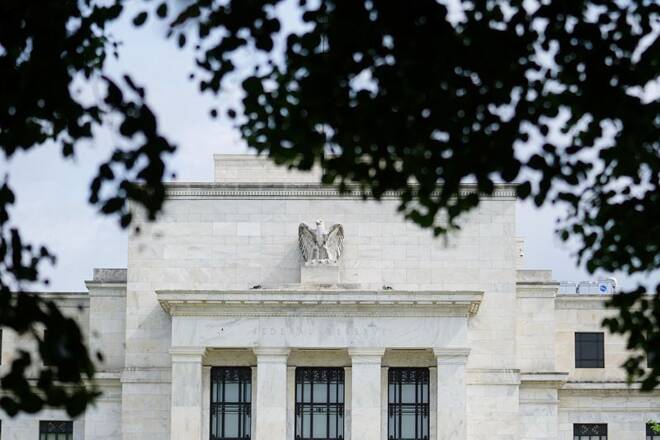Advertisement
Advertisement
Fed says U.S. banks can weather severe downturn comfortably
By:
By Pete Schroeder and Michelle Price WASHINGTON (Reuters) - The largest U.S. banks would remain well capitalized in the event of a severe economic shock, the U.S. Federal Reserve said on Thursday after the lenders' annual health check, paving the way for them to issue buybacks and dividends.
By Pete Schroeder and Michelle Price
WASHINGTON (Reuters) -The largest U.S. banks on Thursday easily cleared the Federal Reserve’s annual health check, in a vote of confidence for the sector amid signs the U.S. economy could tip into a recession in the months ahead.
The results of the Fed’s annual “stress test” exercise showed the banks have enough capital to to weather a severe economic downturn and paves the way for them to issue share buybacks and pay dividends.
The 34 lenders with more than $100 billion in assets that the Fed oversees would suffer a combined $612 billion in losses under a hypothetical severe downturn, the central bank said.
But that would still leave them with roughly twice the amount of capital required under its rules.
As a result, banks including JPMorgan Chase, Bank of America, Wells Fargo, Citigroup, Morgan Stanley and Goldman Sachs can use their excess capital to issue dividends and buybacks to shareholders. Those plans can be announced after the close of trading on Monday.
“We view this as about as positive for the big banks as one could expect from the annual stress test,” Jaret Seiberg, an analyst with Cowen Washington Research Group, said in a research note. “Banks didn’t just perform well. The test showed they could weather a severe downturn with plunging commercial real estate and equity values and surging unemployment levels.”
The country’s largest banking group hailed the results as a sign of the sector’s strong financial health. But Sherrod Brown, the Democratic chair of the U.S. Senate Banking Committee, criticized the exercise as not rigorous enough.
Under the annual stress test exercise established following the 2007-2009 financial crisis, the Fed assesses how banks’ balance sheets would fare against a hypothetical severe economic downturn. The results dictate how much capital banks need to be healthy and how much they can return to shareholders.
While the 2022 scenarios were devised before Russia’s invasion of Ukraine and the current hyper-inflationary outlook, they should give investors and policymakers comfort that the country’s banks are well-prepared for what economists warn is a potential U.S. recession later this year or next.
The 34 banks suffered heavy losses in this year’s scenario, which saw the economy contract 3.5%, driven in part by a slump in commercial real estate asset values, and the jobless rate jumping to 10%. But even then, the Fed said aggregate bank capital ratios were still roughly twice the minimum amount required by regulators.
Strong showing
In 2020 the Fed scrapped the “pass-fail” test model and introduced a more nuanced, bank-specific capital regime.
The test assesses whether banks would stay above the required minimum 4.5% capital ratio – a measure of the cushion banks have to absorb potential losses. Banks that perform well typically stay well above that.
The average capital ratio for the 34 banks was 9.7%, the Fed said. That compares with 10.6% last year, when the Fed tested 23 lenders against a slightly easier scenario.
The average ratio for the country’s eight “globally systemically important banks,” or GSIBs, under the test was 9.64%, according to a Reuters analysis of the results.
Shares in Bank of America, which had the lowest ratio of the GSIBs at 7.6%, slipped in after hours trading, as did shares in Citigroup, whose ratio stood at 8.6.%. Shares in State Street, whose ratio came in at 13.2%, jumped slightly.
Foreign banks U.S. units aced the test, with the average capital ratio for the seven tested coming in at 15.2%.
Overall, regional lender Huntington Bancshares Incorporated had the lowest ratio at 6.8%, while Deutsche Bank’s U.S. operations had the highest ratio at 22.8%.
The test also sets each bank’s “stress capital buffer,” an extra capital cushion on top of the regulatory minimum, the size of which is determined by each bank’s hypothetical losses under the test. The Fed will announce those buffers in the coming months.
Credit Suisse bank analysts this week estimated the average stress capital buffer for big banks will rise to 3.3% from 3.2% in 2021, with the range between 2.5% and 6.3%. The amount of capital lenders will redistribute to shareholders in 2022 will decline roughly 10% from a year earlier, Credit Suisse said.
See an EXPLAINER on the stress tests here:
(Reporting by Pete Schroeder and Michelle Price; additional reporting by Sinead Carew and Elizabeth Dilts Marshall in New York; editing by Deepa Babington)
About the Author
Reuterscontributor
Reuters, the news and media division of Thomson Reuters, is the world’s largest international multimedia news provider reaching more than one billion people every day. Reuters provides trusted business, financial, national, and international news to professionals via Thomson Reuters desktops, the world's media organizations, and directly to consumers at Reuters.com and via Reuters TV. Learn more about Thomson Reuters products:
Did you find this article useful?
Latest news and analysis
Advertisement
